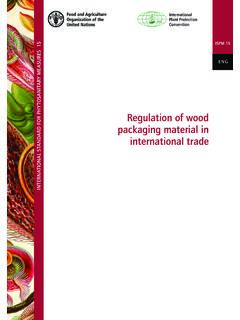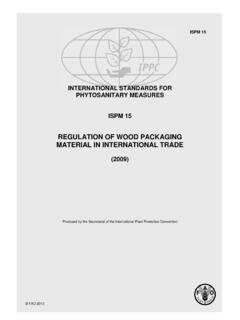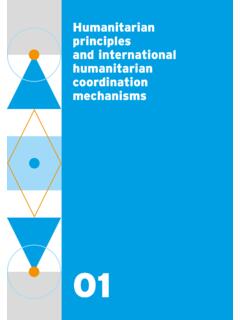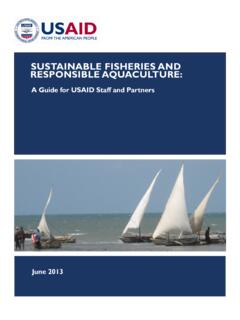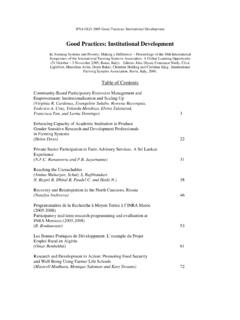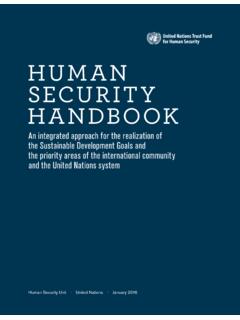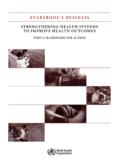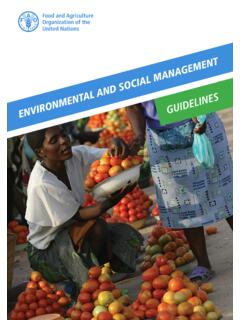Transcription of Explanatory document for ISPM 15 Regulation of wood ...
1 ENGENGP roduced by the Secretariat of the International Plant Protection Convention (IPPC) Explanatory documentfor ISPM 15( Regulation of wood packaging material in international trade)FEB. 2017 The designations employed and the presentation of material in this information product do not imply the expression of any opinion whatsoever on the part of the Food and Agriculture Organization of the United Nations (FAO) concerning the legal or development status of any country, territory, city or area or of its authorities, or concerning the delimitation of its frontiers or boundaries. The mention of specific companies or products of manufacturers, whether or not these have been patented, does not imply that these have been endorsed or recommended by FAO in preference to others of a similar nature that are not mentioned. The views expressed in this information product are those of the author(s) and do not necessarily reflect the views or policies of FAO.
2 FAO, 2014 FAO encourages the use, reproduction and dissemination of material in this information product. Except where otherwise indicated, material may be copied, downloaded and printed for private study, research and teaching purposes, or for use in non-commercial products or services, provided that appropriate acknowledgement of FAO as the source and copyright holder is given and that FAO s endorsement of users views, products or services is not implied in any way. All requests for translation and adaptation rights, and for resale and other commercial use rights should be made via or addressed to Note: Explanatory documents for International Standards for Phytosanitary Measures (ISPMs) are produced as a result of a decision of the Interim Commission on Phytosanitary Measures in 2004 (reported on paragraph 111 of the report of ICPM-6).
3 They are written to provide supporting information to the standard they refer to and cannot be taken as an official legal interpretation of the IPPC or its related documents, and are produced for public information purposes only. Each document is reviewed by experts acting under the auspice of the Secretariat before publication, and the draft document would be made available to the Standards Committee which may comment in the reviewing process. This Explanatory document has been developed with input from the IPPC s Technical Panel on Forest Quarantine. It was circulated to the Standards Committee (SC) via e-decision in February 2014 and SC comments were forwarded to the authors for their consideration. However, the material presented in the Explanatory document remains the opinion of the writer and cannot be interpreted as a decision of the ICPM/CPM.
4 It is hoped that most standards will have one or more Explanatory documents associated with them. Explanatory document for ISPM 15 ( Regulation of wood packaging material in international trade) Written by Shane Sela (lead author), Thomas Schroeder, Matsui Mamoru and Michael Ormsby under the auspices of the IPPC Secretariat. Approved in 2014, published in 2017 2014 Explanatory document for ISPM 15 International Plant Protection Convention Page 3 of 44 CONTENTS Authors .. 5 Introduction and scope .. 5 Definitions .. 6 1. Background .. 6 2. Regulated Articles .. 6 3. Exempt Articles .. 6 4. Establishment of National Requirements .. 7 5. Measures to Reduce Pest Risks Associated with Wood Packaging Material Moving in Trade . 9 Debarking .. 9 Approved treatments .. 9 Other treatments .. 10 Alternative arrangements .. 11 6. Procedures for production of compliant wood packaging.
5 11 Approval of facilities .. 11 Marking .. 12 Reused wood packaging material .. 13 Repaired wood packaging material .. 13 Remanufactured of wood packaging material .. 13 Supervision of manufacture, repair and remanufacture .. 13 7. Procedures for Import .. 14 Import controls .. 14 8. Measures for Non-Compliance at Point of Entry .. 15 ANNEX I: A Guide to Heat Treatment (HT) .. 17 1. Scope .. 17 2. Background information on heat treatment and 17 3. Heat treatment as phytosanitary process .. 17 4. Definitions of terms used in this Annex .. 19 5. Technical requirements for ISPM 15 heat treatment .. 20 The heat chamber .. 20 Loading a heat chamber .. 20 Air Circulation .. 21 Venting .. 24 Humidification .. 24 6. Verification of the Proper Treatment of Wood/Wood Packaging Material .. 24 Heat chamber controllers .. 24 Temperature measurement.
6 25 Number of temperature sensors .. 25 Calibration of temperature sensors .. 26 Wood Temperature Sensors .. 26 Explanatory document for ISPM 15 2014 Page 4 of 44 International Plant Protection Convention Measurement of temperatures in the cold spot .. 27 ANNEX II: A Guide to Methyl Bromide Treatment .. 29 1. Introduction .. 29 2. Relationship Between Pest Biology and Methyl Bromide .. 30 3. General Guidance on Methyl Bromide .. 30 Methyl bromide penetration of wood .. 31 Measuring the methyl bromide dose .. 32 Applying and monitoring methyl bromide .. 32 4. Considerations for Methyl Bromide Fumigation .. 33 Gas concentration .. 33 Fumigation time .. 33 Relationship between concentration, time and temperature .. 33 Numeric value and conversion method as used in fumigation .. 33 Infiltration of methyl bromide gas .. 34 Temperature during fumigation.
7 34 CT product .. 34 Diffusion of gas .. 35 Sorption and desorption of methyl bromide .. 36 5. Types of Fumigation .. 36 Warehouse or chamber fumigation .. 36 Tarpaulin fumigation .. 37 APPENDIX I: Examples of Wood Packaging Material .. 38 APPENDIX II: Examples of Bark on Wood Packaging Material .. 41 APPENDIX III: Examples of Marks .. 43 APPENDIX IV: Resources on Fumigation .. 44 2014 Explanatory document for ISPM 15 International Plant Protection Convention Page 5 of 44 Authors Shane Sela is Chief for Forest Product Market Access in the Plant Biosecurity and Forestry Division, Canadian Food Inspection Agency (CFIA). He has 27 years of service with the CFIA in Plant Biosecurity, mostly related to the establishment of certification programs for forest products and the development of import programs to prevent the entry of quarantine pests.
8 He is Chair of the North American Plant Protection Organization, Forestry Panel since 2000 and a member of the IPPC Technical Panel on Forest Quarantine since 2006. Mr Sela authored the core text and Appendixes I-IV, and co-authored Annex I of this document . Mamoru Matsui is Assistant Director for Bilateral Affairs in the Plant Protection Division, Food Safety and Consumer Affairs of the Ministry of Agriculture, Forestry and Fisheries of Japan. Mr Matsui co-authored Annex II of this document . Thomas Schr der is a Senior Scientist in Forestry Quarantine at the Institute for National and International Plant Health of the Julius K hn-Institut, Federal Research Centre for Cultivated Plants in Germany. Educated as forestry scientist he has 20 years of experience in forest protection with special focus on forestry quarantine. He is a member of the Working Group on EU Plant Health Measures related to Forestry of the European Union Commission, the Panel on Forestry Quarantine of the European and Mediterranean Plant Protection Organisation (EPPO) and the IPPC Technical Panel on Forest Quarantine.
9 Mr Schr der co-authored Annex I of this document . Michael Ormsby received his PhD in plant pathology from Victoria University of Wellington. Since then he has worked as a phytosanitary expert in regulatory roles for the New Zealand Ministry of Agriculture and Forestry (now the Ministry of Primary Industries) for over 18 years. During this time, he has been involved in establishing the New Zealand system for implementing ISPM 15, developing a number of international biosecurity manuals and phytosanitary standards, and authoring risk analyses for a wide range of pests and commodities. He has represented New Zealand in trade discussions with China and India as well as international and regional meetings of the IPPC. Over the last 10 years, he has been a member of the IPPC Technical Panel on Phytosanitary Treatments, the IPPC Technical Panel on Forest Quarantine, and the International Forest Quarantine Research Group.
10 Mr Ormsby co-authored Annex II of this document . Introduction and scope In March 2002, the Commission on Phytosanitary Measures (CPM) adopted ISPM 15 Guidelines for regulating wood packaging material in international trade. In April 2009, a revised standard ISPM 15 Regulation of wood packaging material in international trade was adopted by the CPM-4. The revised standard supersedes the original. In 2013, CPM-8 adopted the revised Annex 1 Approved treatments associated with wood packaging material and made consequential changes to Annex 2 The mark and its application. ISPM 15 establishes guidance to national plant protection organizations (NPPOs) on the Regulation of wood packaging material, which is known as an important pathway in the movement of quarantine pests. ISPM 15 sets out harmonized requirements for the application of treatments to render wood packaging material practically free of quarantine pests.
